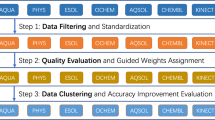Abstract
The aqueous solubility of a drug is a significant factor for its bioavailability. Since many drugs on the market are the oral drugs, their absorption and metabolism in organisms are closely related to its aqueous solubility. As one of the most important properties of drug, the molecule aqueous solubility has received increasing attentions in drug discovery field. The methods of shallow machine learning have been applied to the field of pharmacy, with some success. In this paper, we established a multilayer deep belief network based on semi-supervised learning model to predict the aqueous solubility of compounds. This method can be used for recognizing whether compounds are soluble or not. Firstly, we discussed the influence of feature dimension to predict accuracy. Secondly, we analyzed the parameters of model in predicting aqueous solubility of drugs and contrasted the shallow machine learning with the similar deep architecture. The results showed that the model we proposed can predict aqueous solubility accurately, the accuracy of DBN reached 85.9%. The stable performance on the evaluation metrics confirms the practicability of our model. Moreover, the DBN model could be applied to reduce the cost and time of drug discovery by predicting aqueous solubility of drugs.
Similar content being viewed by others
References
Huuskonen, J., Estimation of aqueous solubility for a diverse set of organic compounds based on molecular topology, J. Chem. Inf. Comput. Sci., 2000, vol. 40, no. 3, pp. 773–777.
Tetko, I.V., Tanchuk, V.Y., Kasheva, T.N., and Villa, A.E., Estimation of aqueous solubility of chemical compounds using e-state indices, J. Chem. Inf. Comput. Sci., 2001, vol. 41, no. 6, pp. 1488–1493.
Lind, P. and Maltseva, T., Support vector machines for the estimation of aqueous solubility, J. Chem. Inf. Comput. Sci., 2003, vol. 43, no. 6, pp. 1855–1859.
Palmer, D.S., O’Boyle, N.M., and Glen, R.C., Random forest models to predict aqueous solubility, J. Chem. Inf. Model., 2007, vol. 47, no. 1, pp. 150–158.
Zhou, D., Yun, A., and Liu, R., Scores of extended connectivity fingerprint as descriptors in QSPR study of melting point and aqueous solubility, J. Chem. Inf. Model., 2008, vol. 48, no. 5, pp. 981–987.
Takashi Kuremoto, Masanao Obayashi, and Kunikazu Kobayashi, Neural forecasting systems, in Reinforcement Learning, 2008.
Hinton, G.E. and Salakhutdinov, R.R., Reducing the dimensionality of data with neural networks, Science, 2006, vol. 313, no. 5786, pp. 504–507.
Hinton, G.E., Osindero, S., and Teh, Y.W., A fast learning algorithm for deep belief nets, Neural Comput., 2006, vol. 18, no. 7, pp. 1527–1554.
Chen, K. and Salman, A., Learning speaker-specific characteristics with a deep neural architecture, IEEE Trans. Neural Networks, 2011, vol. 22, no. 11, pp. 1744–1756.
Abdel-rahman Mohamed, Dong Yu, and Li Deng, Investigation of full-sequence training of deep belief networks for speech recognition, INTERSPEECH 2010, Conference of the International Speech Communication Association, Makuhari, Chiba, 2010, pp. 2846–2849.
Lee, H., Grosse, R., and Ranganath, R., Unsupervised learning of hierarchical representations with convolutional deep belief networks, Commun. ACM, 2011, vol. 54, no. 10, pp. 95–103.
Roy, P.P., Chherawala, Y., and Cheriet, M., Deep-belief-network based rescoring approach for handwritten word recognition, International Conference on Frontiers in Handwriting Recognition, 2014, pp. 506–511.
Zuo, Z. and Wang, G., Learning discriminative hierarchical features for object recognition, IEEE Signal Process. Lett., 2014, vol. 21, no. 9, pp. 1159–1163.
Bengio, Y., Courville, A., and Vincent, P., Representation learning: A review and new perspectives, IEEE Trans. Pattern Anal. Mach. Intell., 2013, vol. 35, no. 8, pp. 1798–1828.
Schölkopf, B., Platt, J., and Hofmann, T., Greedy Layer-Wise Training of Deep Networks, MIT Press, 2007, pp. 153–160.
Fukushima, K., Neocognitron: A self-organizing neural network model for a mechanism of pattern recognition unaffected by shift in position, Biol. Cybernetics, 1980, vol. 36, no. 4, pp. 193–202.
Yu, D., Hinton, G., and Morgan, N., Introduction to the special section on deep learning for speech and language processing, IEEE Trans. Audio Speech Language Process., 2012, vol. 20, no. 1, pp. 4–6.
Roy, P.P., Chherawala, Y., and Cheriet, M., Deep-Belief-Network based rescoring approach for handwritten word recognition, International Conference on Frontiers in Handwriting Recognition, 2014, pp. 506–511.
Larochelle, H., Erhan, D., and Courville, A., An empirical evaluation of deep architectures on problems with many factors of variation, ICML, 2010, pp. 473–480.
Hinton, G.E., Training products of experts by minimizing contrastive divergence, Neural Comput., 2002, vol. 14, no. 8, pp. 1771–1800.
Hinton, G.E., Deep belief networks, Scholarpedia, 2009, vol. 4, no. 6, pp. 786–804.
Hinton, G.E., Dayan, P., and Frey, B.J., The “wake-sleep” algorithm for unsupervised neural networks, Science, 1995, vol. 268, no. 5214, pp. 1158–1161.
Yap, C.W., PaDEL-Descriptor: An open source software to calculate molecular descriptors and fingerprints, J. Comput. Chem., 2011, vol. 32, no. 7, pp. 1466–1474.
Wang, J.T.L., Ma, Q., and Shasha, D., New techniques for extracting features from protein sequences, IBM Syst. J., 2001, vol. 40, no. 2, pp. 426–441.
Author information
Authors and Affiliations
Corresponding author
Additional information
The article is published in the original.
About this article
Cite this article
Li, H., Yu, L., Tian, S. et al. Deep learning in pharmacy: The prediction of aqueous solubility based on deep belief network. Aut. Control Comp. Sci. 51, 97–107 (2017). https://doi.org/10.3103/S0146411617020043
Received:
Accepted:
Published:
Issue Date:
DOI: https://doi.org/10.3103/S0146411617020043




